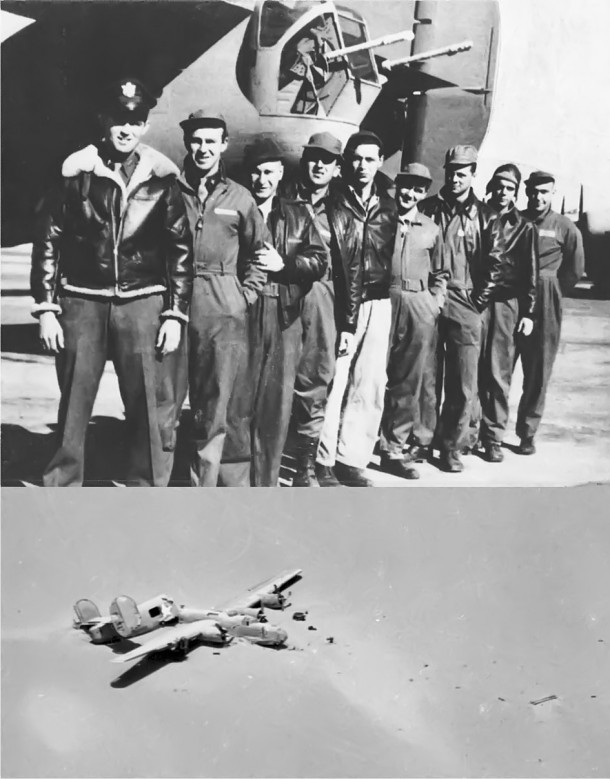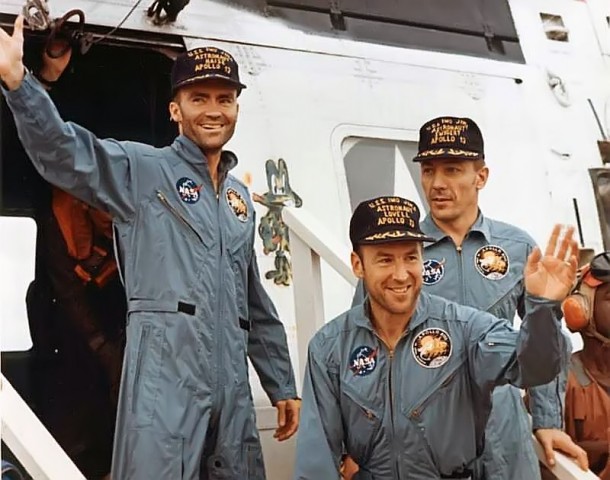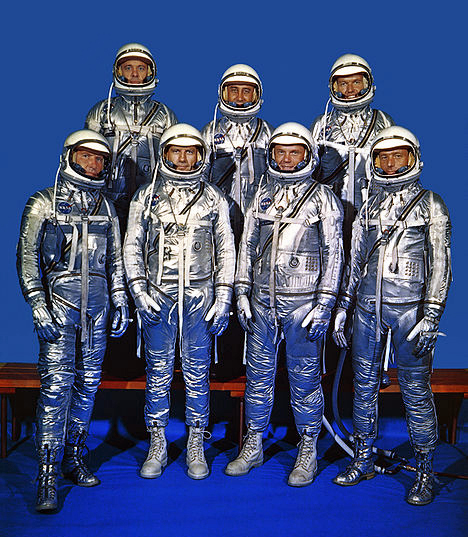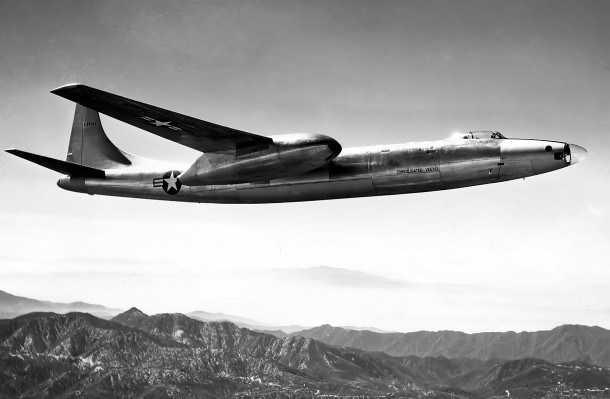
Seventy-one years ago this month, a USAAF/Consolidated B-24D Liberator and her crew vanished upon return from their first bombing mission over Italy. Known as the Lady Be Good, the hulk of the ill-fated aircraft was found sixteen years later lying deep in the Libyan desert more than 400 miles south of Benghazi.
The disappearance of the Lady Be Good and her young air crew is one of the most intriguing and haunting stories in the annals of aviation. Books and web sites abound which report what is now known about that doomed mission. Our purpose here is to briefly recount the Lady Be Good story.
The B-24D Liberator nicknamed Lady Be Good (S/N 41-24301) and her crew were assigned to the USAAF’s 376th Bomb Group, 9th Air Force operating out of North Africa. Plane and crew departed Soluch Army Air Field, Libya late in the afternoon of Sunday, 04 April 1943. The target was Naples, Italy some 700 miles distant.
Listed from left to right as they appear in the photo above, the crew who flew the Lady Be Good on the Naples raid were the following air force personnel:
1st Lt. William J. Hatton, pilot — Whitestone, New York
2nd Lt. Robert F. Toner, co-pilot — North Attleborough, Massachusetts
2nd Lt. D.P. Hays, navigator — Lee’s Summit, Missouri
2nd Lt. John S. Woravka, bombardier — Cleveland, Ohio
T/Sgt. Harold J. Ripslinger, flight engineer — Saginaw, Michigan
T/Sgt. Robert E. LaMotte, radio operator — Lake Linden, Michigan
S/Sgt. Guy E. Shelley, gunner — New Cumberland, Pennsylvania
S/Sgt. Vernon L. Moore, gunner — New Boston, Ohio
S/Sgt. Samuel E. Adams, gunner — Eureka, Illinois
The LBG was part of the second wave of twenty-five B-24 bombers assigned to the Naples raid. Things went sour right from the start as the aircraft took-off in a blinding sandstorm and became separated from the main bomber formation. Left with little recourse, the LBG flew alone to the target.
The Naples raid was less than successful and like most of the other aircraft that did make it to Italy, the LBG ultimately jettisoned her unused bomb load into the Mediterranean. The return flight to Libya was at night with no moon. All aircraft recovered safely with the exception of the Lady Be Good.
It appears that the LBG flew along the correct return heading back towards their Soluch air base. However, the crew failed to recognize when they were over the air field and continued deep into the Libyan desert for about 2 hours. Running low on fuel, pilot Hatton ordered his crew to jump into the dark night.
Thinking that they were still over water, the crewmen were surprised when they landed in sandy desert terrain. All survived the harrowing experience with the exception of bombardier Woravka who died on impact when his parachute failed. Amazingly, the LBG glided to a wings level landing 16 miles from the bailout point.
What happens next is a tale of tragic, but heroic proportions. Thinking that they were not far from Soluch, the eight surviving crewmen attempted to walk out of the desert. In actuality, they were more than 400 miles from Soluch with some of the most forbidding desert on the face of the earth between them and home. They never made it back.
The fate of the LBG and her crew would be an unsolved mystery until British oilmen conducting an aerial recon discovered the aircraft resting in the sandy waste on Sunday, 09 November 1958. However, it wasn’t until Tuesday, 26 May 1959 that USAF personnel visited the crash site. The aircraft, equipment, and crew personal effects were found to be remarkably well-preserved.
The saga about locating the remains of the LBG crew is incredible in its own right. Suffice it to say here that the remains of eight of the LBG crew members were recovered by late 1960. Subsequently, they were respectfully laid to rest with full military honors back in the United States. Despite herculean efforts, the body of Vernon Moore has never been found.
A pair of LBG crew members kept personal diaries about their ordeal in the Libyan desert; co-pilot Toner and flight engineer Ripslinger. These diaries make for sober reading as they poignantly document the slow and tortuous death of the LBG crew. To say that they endured appalling conditions is an understatement. The information the diaries contain suggests that all of the crewmen were dead by Tuesday, 13 April 1943.
Although they did not made it out of the desert, the LBG crewmen far exceeded the limits of human endurance as it was understood in the 1940’s. Five of the crew members traveled 78 miles from the parachute landing point before they succumbed to the ravages of heat, cold, dehydration, and starvation. Their remains were found together.
Desperate to secure help for their companions, Moore, Ripslinger and Shelley left the five at the point where they could no longer travel. Incredibly, Ripslinger’s remains were found 26 miles further on. Even more astounding, Shelley’s remains were discovered 37.5 miles from the group. Thus, the total distance that he walked was 115.5 miles from his parachute landing point in the desert.
We honor forever the memory of the Lady Be Good and her valiant crew. However, we humbly note that theirs is but one of the many cruel and ironic tragedies of war. To the LBG crew and the many other souls whose stories will never be told, may God grant them all eternal rest.

Forty-four years ago this month, the crew of Apollo 13 departed Earth and headed for the Fra Mauro highlands of the Moon. Less than six days later, they would be back on Earth following an epic life and death struggle to survive the effects of an explosion that rocked their spacecraft 200,000 miles from home.
Apollo 13 was slated as the 3rd lunar landing mission of the Apollo Program. The intended landing site was the mountainous Fra Mauro region near the lunar equator. The Apollo 13 crew consisted of Commander James A. Lovell, Jr., Lunar Module Pilot Fred W. Haise, Jr. and Command Module Pilot John L. (Jack) Swigert, Jr. Lovell was making his fourth spaceflight (second to the Moon) while Haise and Swigert were space rookies.
Apollo 13 lifted-off from LC-39A at Cape Canaveral, Florida on Saturday, 11 April 1970. The official launch time was 19:13:00 UTC (13:13 CST). During second stage burn, the center engine shutdown two minutes early as a result of excessive longitudinal structural vibrations. The outer four J-2 engines burned 34 seconds longer to compensate. Arriving safely in low Earth orbit, Lovell observed that every mission seemed to have at least one major glitch. Clearly, Apollo 13′s was now out of the way!
The Apollo 13 payload stack consisted of a Command Module (CM), Service Module (SM) and Lunar Module (LM). The entire ensemble had a lift-off mass of nearly 49 tons. In keeping with tradition, the Apollo 13 crew gave call signs to their Command Module and Lunar Modules. This helped flight controllers distinguish one vehicle from the other over the communications net during mission operations. The CM was named Odyssey and the LM was given the name of Aquarius.
The first two days of the outward journey to the Moon were uneventful. In fact, some at Mission Control in Houston, Texas seemed somewhat bored. The same could be said for the ever-astute press corps who predictably reported that Americans were now responding to the lunar landing missions with a collective yawn. The journalistic sages averred that the space program needed some pepping-up. Going to the Moon might have been impossible yesterday, but today its just run-of-the-mill stuff. Actually, it was all kind of easy. So wrote they of the fickle Fourth Estate.
It all started with a bang at 03:07:53 UTC on Tuesday, 14 April 1970 (21:07:53 CST, 13 April 1970) with Apollo 13 distanced 200,000 miles from Earth. “Houston, we’ve had a problem here.” This terse statement from Jack Swigert informed Mission Control that something ominous had just occurred onboard Apollo 13. Jim Lovell reported that the problem was a “Main B Bus undervolt”. A potentially serious electrical system problem.
But what was the exact nature of the of problem and why did it occur? Nary a soul in the spacecraft nor in Mission Control could provide the answers. All anyone really knew at the moment was that two of three fuel cells formerly supplying electricity to the Command Module were now dead. Arguably more alarming, Oxygen Tank No. 2 was empty with Tank No. 1 losing oxygen at a high rate.
There was something else. The Apollo 13 reaction control system was firing in apparent response to some perturbing influence. But what was it? The answer came with all the subtlety of a sledge hammer blow. Jim Lovell reported that some kind of gas was venting from the spacecraft into space. That chilling observation suddenly explained why the No. 1 oxygen tank was losing pressure so rapidly.
Once Mission Control and the Apollo 13 astronauts fully comprehended the gravity of the situation, the entire team went to work to bring the spacecraft home. Odyssey was powered-down to conserve its battery power for reentry while Aquarius was powered-up and became a makeshift lifeboat. A major problem was that Aquarius had battery power and water sufficient for only 40 hours of flight. The trip home would take 90 hours.
Amazingly, engineering teams at Mission Control conceived and tested means to minimize electrical usage on Aquarius. However, the Apollo 13 crew would have to endure privation and hardships to survive. The cabin temperature in Aquarius got down to 38F and each man was permitted only six ounces of water per day. The walls of the spacecraft were covered with condensation. Sleep was almost impossible and fatigue became another unrelentless enemy to survival.
And then there was the build-up of carbon dioxide. The LM environmental system (EV) was designed to support two men. Now there were three. Between the CM and LM, there was an ample supply of lithium hydroxide canisters to scrub the gas from the cabin atmosphere for the trip home. However, the square CM canisters were incompatible with the circular openings on LM EV. The engineers on the ground invented a device to eliminate this compatibility using materials found onboard the spacecraft.
The Apollo 13 crew had to fire the LM descent motor several times in order to adjust their return trajectory. Use of the SM propulsion system to effect these firings was denied the crew due to concerns that the explosion could have damaged it. These rocket motor firings required precise inertial navigation. The star sightings required for celestial navigation were impossible to make owing to the huge cloud of debris surrounding the spacecraft. Means were devised to use the Sun as the primary navigational source.
As the nation and indeed the world looked on, the miracle of Apollo 13 slowly unfolded. Many a humble heart uttered a prayer for and in behalf of the trio of astronauts. Millions throughout the world followed the men’s journey home via newspaper, radio, television and other media.
As Apollo 13 approached the Earth, the overriding issue was whether the systems onboard Odyssey could be successfully brought back on line. The walls and instrument panels of the craft were drenched with condensation. Unquestionably, the electronics and wiring bundles behind those instrument panels were also soaking wet. Would they short-out once electrical energy flowed through them again? Would there be enough battery power for reentry?
Happily, the CM power-up sequence was successfully accomplished. Once again the resourceful engineers at Mission Control produced under extreme duress. They devised an intricate and never-attempted-in-flight power-up sequence for the CM. Too, the extra insulation added to the CM’s electrical system in the aftermath of the Apollo 1 fire provided protection from condensation-induced electrical arcing.
Approximately four hours prior to reentry, the Apollo 13 crew jettisoned the SM. What they saw was shocking. The module was missing a complete external panel and most of the equipment inside was gone or significantly damaged. One hour prior to entry, Aquarius, their trusty space lifeboat, was also jettisoned. The only concern now was whether the Command Module base heatshield had survived the explosion intact.
On Friday, 17 April 1970, Odyssey hit entry interface (400,000 feet) at 36,000 feet per second. Other than a worrisome additional 33 seconds of plasma-induced communications blackout (4 minutes, 33 seconds total), the reentry was entirely nominal. Splashdown occurred at 18:07:41 UTC near American Samoa in the Pacific Ocean. The USS Iwo Jima quickly recovered spacecraft and crew.
The post-flight mishap investigation revealed that Oxygen Tank No. 2 exploded when the crew conducted a cryo-stir of its multi-phase contents. Unknown to all was the fact that a mismatch between the tank heater and thermostat had resulted in the Teflon insulation of the internal wiring being severely damaged during previous ground operations. This meant that the tank was now a bomb and would detonate its contents when used the next time. In this case, the next time was in flight. The warning signs were there, but went unheeded.
Apollo 13 never landed at Fra Mauro. And none of its crew would ever again fly in space. But in many ways, Apollo 13 was NASA’s finest hour. Overcoming myriad seemingly intractable obstacles in the aftermath of a completely unanticipated catastrophe, deep in trans-lunar space, will forever rank high among the legendary accomplishments of spaceflight. With essentially no margin for error and in the harsh glare of public scrutiny, NASA wrested victory from the tentacles of almost certain failure and brought three weary men safely back to their home planet.

Fifty-five years ago this month, NASA held a press conference in Washington, D.C. to introduce the seven men selected to be Project Mercury Astronauts. They would become known as the Mercury Seven or Original Seven.
Project Mercury was America’s first manned spaceflight program. The overall objective of Project Mercury was to place a manned spacecraft in Earth orbit and bring both man and machine safely home. Project Mercury ran from 1959 to 1963.
The men who would ultimately become Mercury Astronauts were among a group of 508 military test pilots originally considered by NASA for the new role of astronaut. The group of 508 candidates was then successively pared to 110, then 69 and finally to 32. These 32 volunteers were then subjected to exhaustive medical and somewhat bizarre psychological testing.
A total of 18 men were still under consideration for the astronaut role at the conclusion of the demanding test period. Now came the hard part for NASA. Each of the 18 finalists was truly outstanding and would be a worthy finalist. But there were only 7 spots on the team.
On Thursday, 09 April 1959, NASA publicly introduced the Mercury Seven in a special press conference held for this purpose at the Dolley Madison House in Washington, D.C. The men introduced to the Nation that day will forever hold the distinction of being the first official group of American astronauts. In the order in which they flew, the Mercury Seven were:
Alan Bartlett Shepard Jr., United States Navy. Shepard flew the first Mercury sub-orbital mission (MR-3) on Friday, 05 May 1961. He was also the only Mercury astronaut to walk on the Moon. Shepherd did so as Commander of Apollo 14 (AS-509) in February 1971. Alan Shepard died from leukemia on 21 July 1998 at the age of 74.
Vigil Ivan Grissom, United States Air Force. Grissom flew the second Mercury sub-orbital mission (MR-4) on Friday, 21 July 1961. He was also Commander of the first Gemini mission (GT-3) in March 1965. Gus Grissom might very well have been the first man to walk on the Moon. But he died in the Apollo 1 Fire, along with Astronauts Edward H. White II and Roger Chaffee, on Friday, 27 January 1967. Gus Grissom was 40 at the time of his death.
John Herschel Glenn Jr., United States Marines. Glenn was the first American to orbit the Earth (MA-6) on Thursday, 22 February 1962. He was also the only Mercury Astronaut to fly a Space Shuttle mission. He did so as a member of the STS-95 crew in October of 1998. Glenn was 77 at the time and still holds the distinction of being the oldest person to fly in space. John Glenn is the only Mercury Seven astronaut still living and will be 93 in July 2014.
Malcolm Scott Carpenter, United States Navy. Carpenter became the second American to orbit the Earth (MA-7) on Thursday, 24 May 1962. This was his only mission in space. Carpenter subsequently turned his attention to under-sea exploration and was an aquanaut on the United States Navy SEALAB II project. Scott Carpenter passed away on 10 October 2013 at the age of 88.
Walter Marty Schirra Jr., United States Navy. Schirra became the third American to orbit the Earth (MA-8) on Wednesday, 03 October 1962. He later served as Commander of Gemini 6A (GT-6) in December 1965 and Apollo 7 (AS-205) in October 1968. Schirra was the only Mercury Astronaut to fly Mercury, Gemini and Apollo space missions. Wally Schirra suffered a fatal heart attack in May 2007 at the age of 84.
Leroy Gordon Cooper Jr., United States Air Force. Cooper became the fourth American to orbit the Earth (MA-9) on Wednesday, 15 May 1963. In doing so, he flew the last and longest Mercury mission (22 orbits, 34 hours). Cooper was also Commander of Gemini 5 (GT-5), the first long-duration Gemini mission, in August 1965. Gordo Cooper died from heart failure in October 2004 at the age of 77.
Donald Kent Slayton, United States Air Force. Slayton was the only Mercury Astronaut to not fly a Mercury mission when he was grounded for heart arrythemia in 1962. He subsequently served many years on Gemini and Apollo as head of astronaut selection. He finally got his chance for spaceflight in July 1975 as a crew member of the Apollo-Soyuz mission (ASTP). Deke Slayton succumbed to brain cancer in June of 1993 at the age of 69.
History records that the Mercury Seven was the only group of NASA astronauts that had a member that flew each of America’s manned spacecraft (i.e, Mercury, Gemini, Apollo and Shuttle). Though just men and imperfect mortals, we salute each of them for their genuinely heroic deeds and unique contributions made to the advancement of American manned spaceflight.

Sixty-seven years ago today, the USAF/Convair XB-46 took to the skies on its maiden flight. Convair test pilot Ellis D. “Sam” Shannon was at the controls of the sleek, multi-jet prototype medium range bomber.
The XB-46 was a product of the flurry of aircraft design-build-and-fly activity that gripped the American aviation industry in the second half of the 1940’s. While most never saw the production line, all manner of new and innovative aircraft design concepts were built and flown by aircraft companies.
The XB-46 was a contemporary of and competitor with other jet-powered bomber concepts such as the North American XB-45 Tornado, North American XB-47 Stratojet, and Martin XB-48. With an unrefueled range of 2,500 nm and a service ceiling of 40,000 feet, the XB-46 was designed to carry a bomb load of 22,000 lbs.
The big bomber measured 105.75 feet in length and had a wingspan of 113 feet. Power was provided by a quartet of J35 turbojets which delivered 16,000 lbs of sea level thrust. The type’s gross take-off and empty weights were 95,000 lbs and 48,000 lbs, respectively.
The XB-46’s air crew consisted of a pilot and co-pilot who sat in tandem as well as a third crew member who was situated in the nose. This latter individual was a real jack-of-all-trades who served as the bombardier, navigator, and radio operator.
The one and only XB-46 aircraft (S/N 45-59582) departed on its first flight from Convair’s Lindbergh Field in San Diego on Wednesday, 02 April 1947. Pilot Sam Shannon headed north to Muroc Army Air Field where he safely landed an hour and a half later following an uneventful flight.
By the end of September 1947, the lone XB-46 aircraft had made 64 flights and spent 127 hours in the air. While the aircraft was found to have excellent stability and control characteristics and favorable handling qualities, the rapid pace of aeronautical progress quickly rendered it obsolete.
Although the XB-46 project was cancelled in August 1947, the airplane was transferred to Florida’s Palm Beach Air Force Base for additional flight testing. Researchers focused primarily on airframe structural and vibrational issues during the 44 hours of flight testing that took place from August 1948 to August 1949.
Although a worthy design concept that flew well, the XB-46 was eclipsed by a better airplane. In this case, the legendary USAF/Boeing B-47 Stratojet. But such was the fate of many post-WWII aircraft projects that vied for military production contracts during the fifth and sixth decades of the twentieth century.
The XB-46 exhibited a certain majesty in flight that was emblematic of the early jet age. Its development helped to improve the art of designing and flying large aircraft. As such, it would be nice to see it displayed in a prominent aviation museum. Regrettably, the single XB-46 prototype airframe was scrapped in the early 1950’s and no longer exists.





